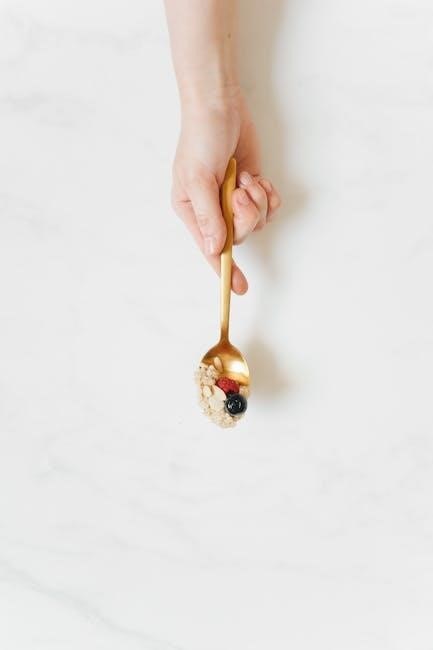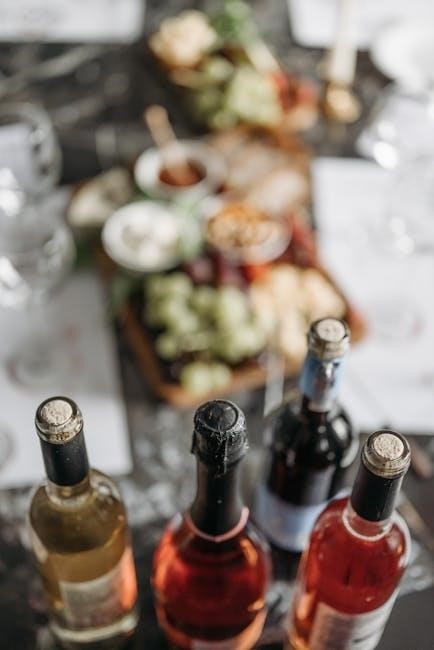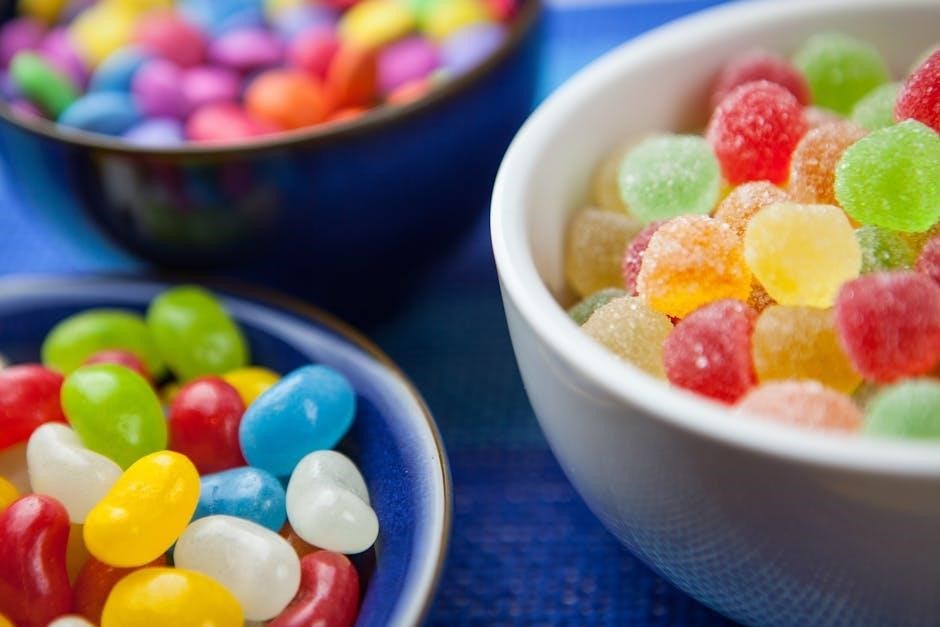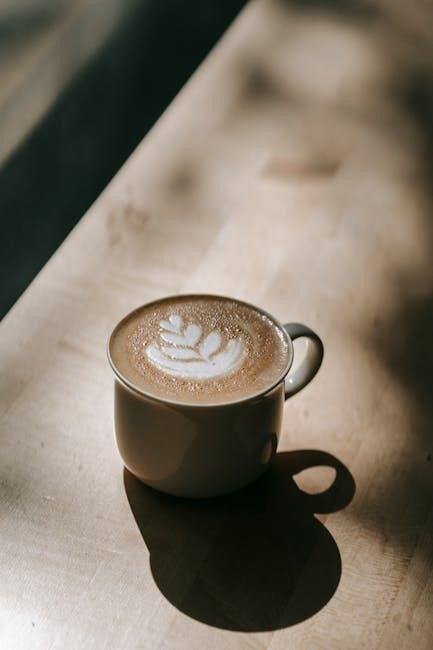joshua weissman texture over taste pdf

Joshua Weissman’s “Texture Over Taste” revolutionizes cooking by prioritizing texture’s role in enhancing culinary experiences, offering practical insights and techniques for home cooks and professionals alike.
Overview of Joshua Weissman’s Culinary Philosophy
Joshua Weissman’s culinary philosophy, as outlined in his work Texture Over Taste, emphasizes the transformative power of texture in cooking. He advocates for a balanced approach that prioritizes both texture and flavor, arguing that texture often plays a more significant role in creating memorable dining experiences. Weissman’s philosophy is rooted in the idea that texture adds depth and complexity to dishes, making them more engaging for the palate. His approach encourages cooks to think beyond traditional flavor profiles and explore how different textures can elevate a dish. By focusing on the interplay between ingredients and techniques, Weissman provides a framework for understanding how texture can enhance the overall culinary experience. His philosophy is both practical and innovative, offering insights that resonate with home cooks and professional chefs alike.
The Concept of “Texture Over Taste” Explained

Joshua Weissman’s “Texture Over Taste” introduces a groundbreaking culinary concept that prioritizes texture as the primary driver of a dish’s appeal. Weissman argues that while flavor is essential, texture plays a more significant role in creating memorable and satisfying culinary experiences. He emphasizes that texture adds depth, complexity, and engagement to food, making it a critical element in both home cooking and professional cuisine. The concept encourages cooks to focus on achieving a variety of textures—such as crispiness, creaminess, or crunch—in their dishes to elevate them beyond mere flavor profiles. By understanding and mastering texture, cooks can create meals that are not only delicious but also visually and tactilely appealing, ensuring a more immersive dining experience for everyone;
Why Texture Matters in Modern Cooking
Texture plays a pivotal role in modern cooking, as it enhances the sensory experience of dining, making meals more engaging and memorable. Joshua Weissman highlights that texture adds depth and complexity to dishes, often surpassing flavor in its ability to captivate diners. A well-balanced texture can elevate a dish from ordinary to extraordinary, creating a multisensory experience that delights the eyes, hands, and mouth. In today’s culinary landscape, where visual appeal and Instagram-worthy presentations are paramount, texture contributes significantly to a dish’s aesthetic and tactile appeal. Moreover, texture caters to diverse dietary preferences and restrictions, offering versatility for cooks to experiment with ingredients and techniques. By prioritizing texture, modern cooking becomes more inclusive, innovative, and satisfying, ensuring that every bite tells a story and leaves a lasting impression.
Key Principles of “Texture Over Taste”
Joshua Weissman’s “Texture Over Taste” emphasizes balancing contrasting textures, understanding ingredient roles, and mastering techniques to create harmonious, engaging dishes that elevate the dining experience effectively.

The Role of Texture in Elevating Dishes
Texture plays a pivotal role in enhancing the culinary experience by adding depth and complexity to dishes. It engages the senses, creating a multisensory experience that goes beyond flavor. Contrasting textures, such as crunchy and smooth, can elevate a dish from mundane to extraordinary. Joshua Weissman emphasizes how texture can transform a meal, making it more engaging and memorable. By balancing elements like crispiness, creaminess, and tenderness, chefs can craft dishes that delight the palate and leave a lasting impression. Texture not only enhances flavor perception but also adds a layer of sophistication, making it a cornerstone of modern culinary innovation. Understanding and mastering texture allows cooks to create harmonious, visually appealing, and satisfying meals that stand out.
Understanding the Science Behind Texture
Texture in cooking is deeply rooted in the physical and chemical properties of ingredients. It is perceived through mouthfeel, which involves sensations like crispness, smoothness, or chewiness. Ingredients such as fats, proteins, and carbohydrates contribute uniquely to texture, with fats adding richness and proteins providing structure. Cooking techniques like heating or cooling can alter these properties, transforming textures—e.g., gelatinization of starches or denaturation of proteins. Understanding these principles allows chefs to predict and control texture outcomes. Joshua Weissman highlights how mastering texture requires a grasp of both ingredient behavior and culinary processes. By manipulating these elements, cooks can create dishes with balanced, engaging textures that enhance the dining experience. This scientific approach to texture elevates cooking from art to a precise, predictable craft, enabling innovation and consistency in the kitchen.
Balancing Texture with Flavor
Balancing texture with flavor is a cornerstone of Joshua Weissman’s culinary philosophy. While texture enhances the sensory experience, flavor provides depth and complexity. Weissman emphasizes that these elements are not mutually exclusive but rather complementary. A dish with varied textures can elevate flavor perception, making each bite more engaging. Conversely, harmonious flavors can highlight textural contrasts. For instance, a crispy exterior on a tender roast chicken complements the savory flavors of the meat. Weissman advocates for layering both elements to create a cohesive and satisfying dish. This balance ensures that neither texture nor flavor overpowers the other, resulting in a harmonious culinary experience. By understanding how to pair textures with flavors, cooks can craft meals that are both visually appealing and delicious, ensuring every bite is a delight for the senses.
The Importance of Mouthfeel in Culinary Experiences
Mouthfeel, a critical aspect of Joshua Weissman’s “Texture Over Taste” philosophy, refers to the physical sensations food creates in the mouth. It encompasses textures, temperatures, and sensations like creaminess, crunch, or smoothness. Mouthfeel significantly enhances the dining experience, making meals more engaging and satisfying. Weissman argues that a dish’s mouthfeel can elevate its appeal, even if flavors are subtle. For example, the velvety smoothness of a well-made risotto or the satisfying crunch of a freshly baked baguette can create lasting impressions. By carefully crafting mouthfeel, cooks can evoke emotions and memories, transforming a simple meal into a memorable culinary journey. This focus on sensory details highlights how texture and mouthfeel work together to create a holistic dining experience, proving that food is not just about taste but about how it feels to eat it.
The Science of Texture in Cooking
The science of texture in cooking involves understanding how ingredients like proteins, fats, and carbohydrates behave under different conditions, enabling precise control over a dish’s final texture.
How Different Ingredients Contribute to Texture
Different ingredients play unique roles in shaping a dish’s texture. Proteins like eggs and gelatin provide structure and elasticity, while fats such as butter and oil add creaminess and richness. Starches, found in grains and root vegetables, contribute crispness or softness depending on preparation. Acids like vinegar or citrus break down ingredients, creating tender textures. Emulsifiers, such as lecithin in egg yolks, stabilize mixtures, ensuring smoothness. Herbs and spices, while primarily for flavor, can enhance textural contrasts. Understanding how each ingredient behaves under various conditions allows chefs to craft dishes with desired mouthfeel, from crunchy to silky. This knowledge is central to Joshua Weissman’s approach, enabling the creation of balanced, engaging culinary experiences.
Techniques for Achieving Desired Textures
Achieving desired textures in cooking involves mastering various techniques that manipulate ingredients’ physical properties. Searing and roasting enhance crispiness, while braising and sous vide ensure tender results. Emulsification, such as in mayonnaise, creates smoothness by stabilizing liquids; Gelification, using agar or pectin, adds firmness to dishes like jellies. Blanching and shocking preserve vegetables’ crunch, while pickling introduces tangy, firm textures. Grinding and pureeing transform ingredients into creamy or powdery consistencies. Sous vide precision ensures uniform doneness, avoiding overcooking. These methods, explored in Joshua Weissman’s guide, empower cooks to craft dishes with intentional texture, elevating both visual and sensory appeal. By understanding and applying these techniques, home cooks and professionals can create balanced, engaging meals that delight the palate and satisfy the senses.
The Role of Temperature and Time in Texture Development
Temperature and time are critical factors in developing desired textures in cooking. High heat can create a crispy exterior, while low heat over extended periods tenderizes ingredients. Sous vide techniques rely on precise temperature control to achieve uniform textures. Caramelization, for instance, requires specific heat levels to develop a crunchy, sweet crust. Conversely, overcooking can lead to undesirable mushiness. Time management is equally vital; prolonged cooking breaks down connective tissues, making meats tender, while quick cooking preserves crispness in vegetables. Understanding how temperature and time interact with ingredients is essential for mastering texture. This interplay is a cornerstone of Joshua Weissman’s approach, enabling cooks to manipulate textures intentionally. By controlling these elements, chefs can transform raw ingredients into dishes with complex, satisfying mouthfeels that elevate the dining experience.

Practical Applications of “Texture Over Taste”

Practical applications of “Texture Over Taste” involve enhancing dishes through deliberate texture choices, like roasting for crispiness, tenderizing meats, and layering textures for a dynamic, everyday mouthfeel experience.
Everyday Cooking Tips for Enhancing Texture

Enhancing texture in everyday cooking can elevate simple dishes to new heights. Start by understanding how ingredients naturally contribute to texture, such as the crunch of fresh vegetables or the tenderness of slow-cooked meats. Roasting vegetables like Brussels sprouts or broccoli until caramelized adds a satisfying crispiness, while marinating meats ensures they stay juicy and tender. Don’t overlook the power of acidity, like a squeeze of lemon or vinegar, to brighten and balance textures. Incorporate a variety of cooking techniques, such as sautéing for a quick sear or braising for deep, unctuous results. Tools like a mandoline or food processor can help achieve precise textures, from thin slices to creamy purées. Finally, experiment with layering textures in a single dish, combining crunchy, soft, and chewy elements for a dynamic mouthfeel that keeps meals interesting and engaging.
Advanced Culinary Techniques for Texture Mastery
Mastery of texture in cooking often requires advanced techniques that go beyond basic kitchen skills. Sous vide cooking, for instance, allows for precise control over the doneness and texture of meats and vegetables, ensuring uniform results. Molecular gastronomy techniques, such as spherification or foam creation, can add unique and intriguing textures to dishes. Dehydration is another powerful method, used to create crispy elements like chips or powders that add depth to plates. Tools like thermomixers and ultrasonic homogenizers enable chefs to manipulate ingredients at a molecular level, achieving textures that are both innovative and refined. These techniques, while complex, offer unparalleled control over the sensory experience of a dish, making them indispensable for chefs aiming to push culinary boundaries. Balancing these advanced methods with flavor remains key to creating truly memorable meals.
Case Studies: Iconic Dishes Rethought Through Texture
Joshua Weissman reimagines classics like burgers and salads, enhancing texture with crispy elements and creative, vibrant toppings for a fresh, innovative culinary experience.
Classic Recipes Reimagined with Texture in Mind
Joshua Weissman breathes new life into timeless dishes by emphasizing texture, transforming familiar flavors into extraordinary experiences. For instance, he reimagines the humble burger by layering crispy, caramelized onions alongside a tender patty, creating a harmonious balance of textures. Similarly, his approach to salads involves juxtaposing crunchy vegetables with creamy dressings, elevating simplicity to sophistication. Weissman’s philosophy encourages home cooks to experiment with texture, whether through roasting, frying, or raw preparation, to add depth to classic recipes. By focusing on mouthfeel, he demonstrates how even the most traditional dishes can be reinvented, offering a fresh perspective on culinary creativity. This approach not only enhances flavor but also engages the senses, making everyday meals more satisfying and memorable.
Modern Twists on Traditional Cuisine
Joshua Weissman’s “Texture Over Taste” inspires chefs to reimagine classic dishes with contemporary flair, blending tradition with innovation. By incorporating modern techniques like spherification or foam, Weissman transforms familiar flavors into visually stunning and texturally intriguing creations. For example, he reimagines a traditional soufflé by adding a crispy, caramelized exterior, contrasting with its airy interior. Similarly, he updates sushi rolls by introducing unexpected textures, such as toasted nuts or pickled vegetables, to enhance the dining experience. Weissman’s approach encourages cooks to experiment with cutting-edge methods while respecting the essence of traditional cuisine. This fusion of old and new not only revitalizes beloved recipes but also pushes the boundaries of culinary artistry, proving that texture can be a powerful tool for modernizing classic dishes. His ideas inspire creativity, making traditional meals feel fresh and exciting for modern palates.

The “Texture Over Taste” PDF: A Deep Dive
Joshua Weissman’s ‘Texture Over Taste’ PDF offers a comprehensive guide to culinary techniques, emphasizing texture’s role in enhancing dishes and exploring the science behind mouthfeel.
Structure and Content of the PDF
Joshua Weissman’s “Texture Over Taste” PDF is structured to guide cooks through the fundamentals of texture in cooking. It begins with an introduction to Weissman’s culinary philosophy, emphasizing how texture elevates dishes beyond flavor alone. The document is divided into sections, each focusing on specific aspects of texture, such as its role in modern cuisine, the science behind mouthfeel, and practical techniques for achieving desired textures. Readers will find detailed explanations of how various ingredients contribute to texture, along with step-by-step guides for mastering techniques like emulsification, gelification, and textural contrast. The PDF also includes case studies of iconic dishes reimagined with texture as the primary focus, offering inspiration for both home cooks and professional chefs. Visual aids and diagrams complement the text, making complex concepts accessible. Overall, the guide balances theory with practicality, providing readers with actionable insights to enhance their cooking skills and creativity in the kitchen.
Key Takeaways and Insights from the Guide
Joshua Weissman’s “Texture Over Taste” PDF offers transformative insights into the importance of texture in cooking, challenging traditional culinary approaches that prioritize flavor alone. A key takeaway is the idea that texture is not just a sensory experience but a fundamental element that elevates dishes to new heights. Weissman emphasizes the balance between texture and flavor, demonstrating how each complements the other to create harmonious culinary experiences. The guide also highlights the science behind mouthfeel, explaining how different ingredients and techniques can manipulate texture to achieve desired outcomes. Practical tips, such as layering textures in a dish and understanding the role of temperature and time, provide readers with actionable steps to enhance their cooking. By focusing on texture as a storytelling element, Weissman encourages cooks to think creatively and experiment with new ways to engage the senses. This guide is a must-read for anyone looking to innovate and refine their culinary skills.
How to Apply the Concepts in Your Kitchen
Applying the principles of “Texture Over Taste” in your kitchen begins with a focus on intentional ingredient selection and technique. Start by experimenting with contrasting textures—crunchy, smooth, tender, and crisp—to add depth to your dishes. Incorporate a variety of elements like roasted vegetables, toasted nuts, or crispy garnishes to elevate simple meals. Pay attention to mouthfeel by balancing soft and firm components, ensuring each bite is engaging. Practice techniques like roasting, frying, and emulsification to achieve desired textures. Layering textures in a dish, such as pairing creamy sauces with crunchy toppings, can create a harmonious culinary experience. Weissman’s guide encourages home cooks to think creatively, using everyday ingredients to craft meals that delight the senses. By applying these concepts, you can transform ordinary recipes into extraordinary dishes that leave a lasting impression.

Joshua Weissman’s “Texture Over Taste” reshapes culinary perspectives, proving texture’s profound impact on dining experiences, inspiring home cooks and professionals to embrace this innovative approach wholeheartedly.

The Future of Culinary Innovation: Texture-Forward Cooking
Joshua Weissman’s “Texture Over Taste” heralds a new era in culinary innovation, where texture becomes the cornerstone of dish design. By prioritizing texture, chefs and home cooks alike can create meals that are not only visually stunning but also deeply satisfying. This approach encourages experimentation with contrasting elements—crunchy, smooth, tender, and crisp—to craft dishes that engage the senses on multiple levels. As the culinary world evolves, texture-forward cooking is poised to redefine how we experience food, making it a cornerstone of modern gastronomy. This shift not only enhances flavor but also fosters creativity, pushing the boundaries of traditional cooking techniques. With Weissman’s insights, the future of cooking is set to be as tactile as it is flavorful, inspiring a new generation of culinary artists to embrace texture as a primary driver of innovation.
Encouraging Experimentation and Creativity in the Kitchen

Joshua Weissman’s “Texture Over Taste” philosophy serves as a catalyst for creativity, empowering cooks to explore beyond traditional recipes. By focusing on texture, home cooks and professionals alike are inspired to experiment with diverse ingredients and techniques, creating unique culinary experiences. This approach breaks down the barriers of conventional cooking, allowing for the discovery of new flavor combinations and textural contrasts. Weissman’s guide encourages cooks to think outside the box, embracing the freedom to innovate and personalize dishes. Whether it’s incorporating unexpected elements or reimagining classic recipes, the emphasis on texture fosters a sense of adventure in the kitchen. This mindset not only enhances creativity but also makes cooking more engaging and rewarding, turning everyday meals into opportunities for artistic expression and satisfaction.